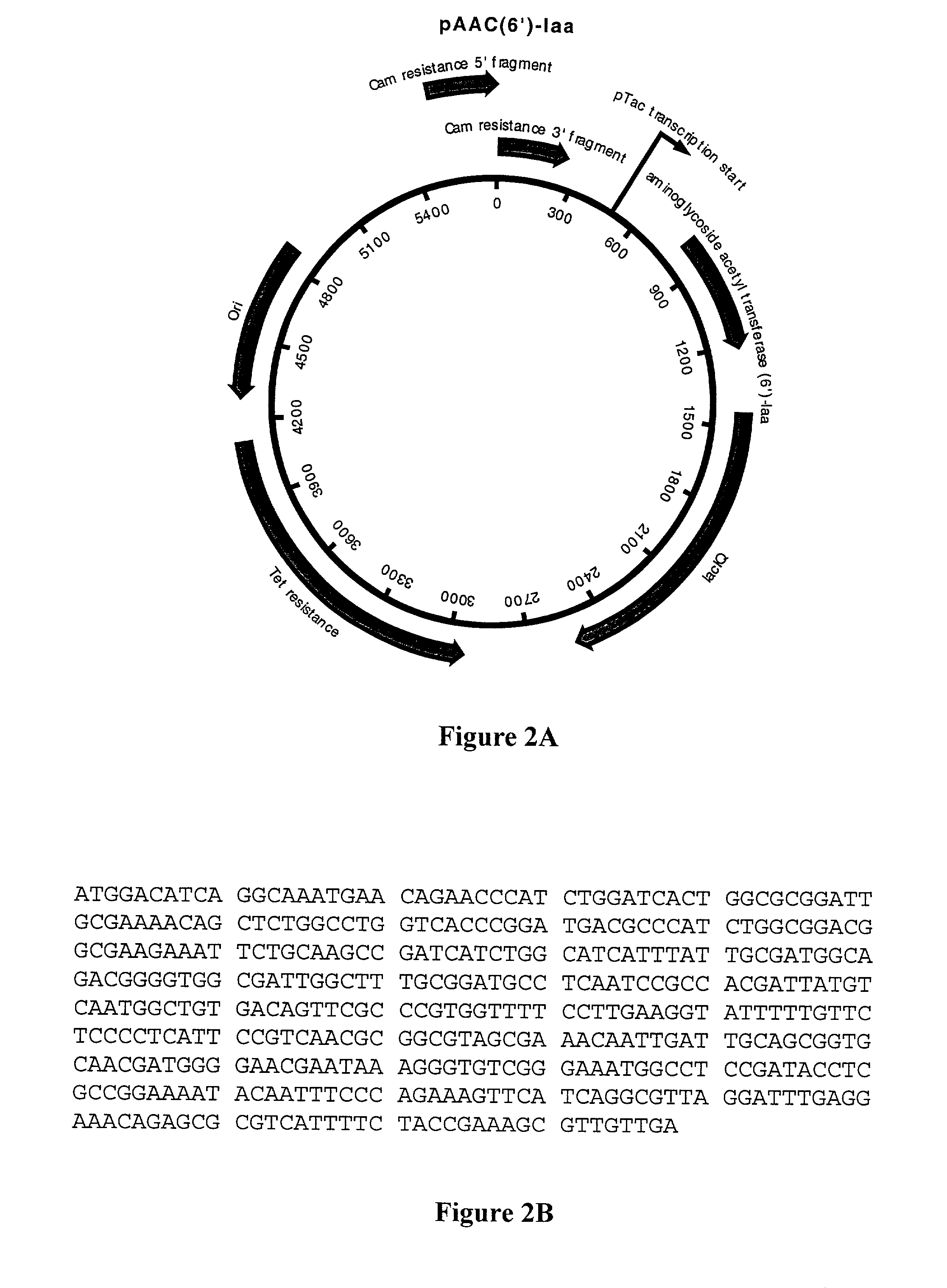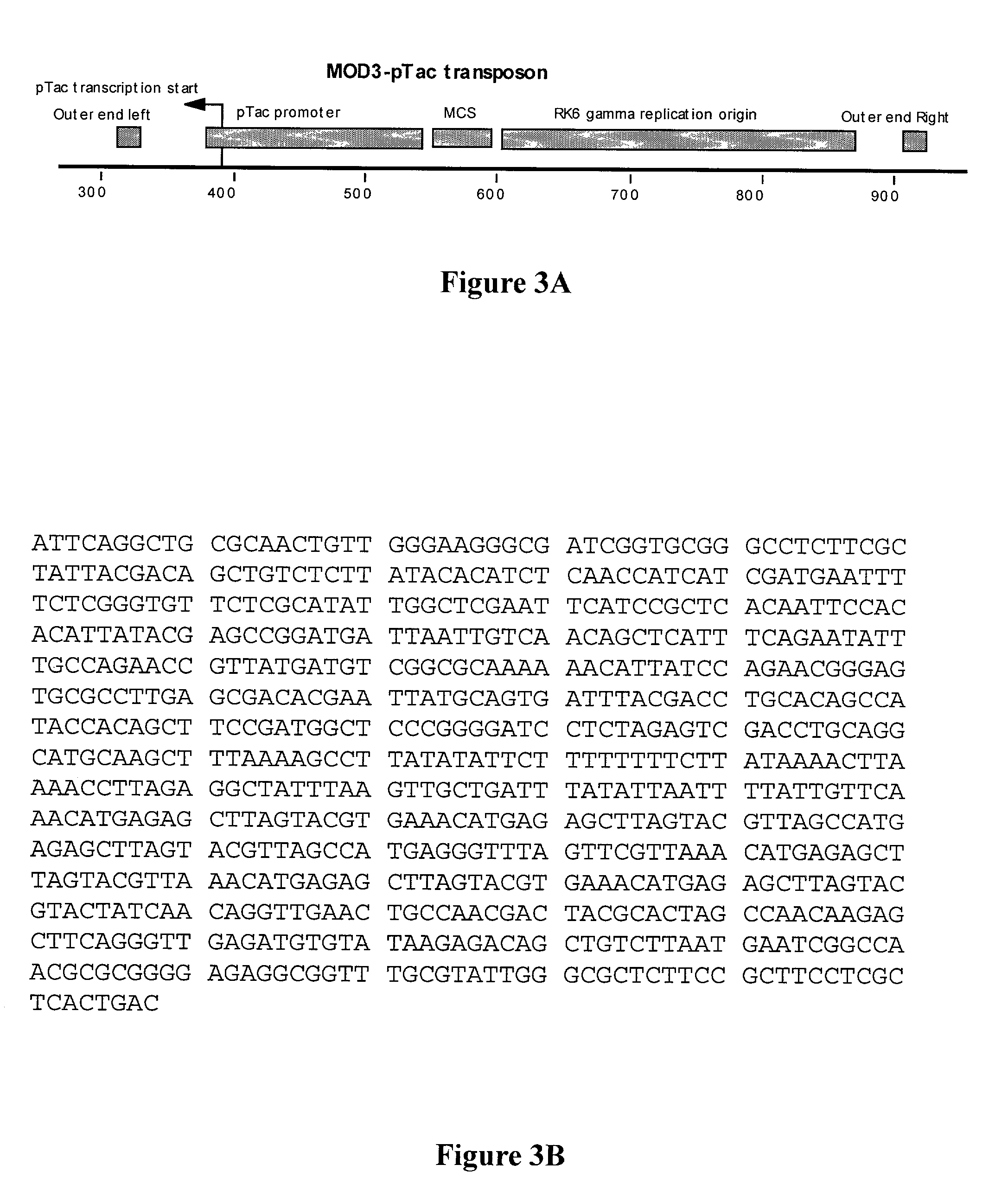Method of identifying putative antibiotic resistance genes
a technology of antibiotic resistance and putative genes, applied in the field of identifying to achieve the effect of effectively combating the resistance capacity of these putative antibiotic resistance genes
- Summary
- Abstract
- Description
- Claims
- Application Information
AI Technical Summary
Benefits of technology
Problems solved by technology
Method used
Image
Examples
example 1
Evidence for the Importance of Primitive, Chromosomally Located, Potential Resistance Genes
[0069]E. coli K12 ampC
[0070]The ampC gene of E. coliK12 is so poorly expressed that deletion of that gene has no effect at all on resistance to β-lactamase antibiotics. Yet when that same gene is cloned into a plasmid and expressed under the control of an effective promoter, it confers clinical resistance to three important drugs: ampicillin, cephalothin, and cefuroxime (Lindberg and Normark, “Contribution of Chromosomal Beta-lactamases to Beta-lactam Resistance in Enterobacteria,”Rev. Infect. Dis. 8 Suppl 3:S292–304 (1986), which is hereby incorporated by reference in its entirety). E coliK12 was isolated in the mid-1920's, thus its ampC gene did not evolve that level of resistance in response to selection from antibiotics in clinical use (i.e., it was already predisposed to confer resistance). In addition, as the result of two or three laboratory-induced mutations, that gene can evolve furth...
example 2
Computer-Assisted Identification of Salmonella enteritidis Serovar typhimurium Gene and Measure of its Mutagenic Potential
[0075]The aminogylcoside N6′-acetyltransferase Ic protein of Serratia marcescens (AAC(6′)-Ic) (Genbank Accession Nos. AAA26549 and M94066, each of which is hereby incorporated by reference in its entirety) was used to search the NCBI database of complete and incomplete microbial genomes. A sequence in the incompletely sequenced genome of Salmonella enteritidis serovar typhimurium strain LT2 was identified that encodes a protein that is 51% identical and 66% similar to the S. marcescens AAC(6′)-IC protein. Alignment of the two nucleotide sequences showed no significant similarity.
[0076]AAC(6′)-I family aminogylcoside acetyltransferases tend to confer resistance to the aminoglycosides kanamycin, tobramycin, gentamycin, and amikacin. Table 2 (below) shows that Salmonella enteritidis serovar typhimurium strain LT2 is sensitive to each of those drugs.
[0077]
TABLE 2Anti...
example 3
Construction of MOD3-pTac Transposon
[0086]Plasmid pMOD3-Trc was constructed as follows. The pTac promoter was amplified from plasmid pSE380 (Invitrogen, San Diego, Calif.) using primers such that the 3′ end of each primer corresponds, respectively to bp 63–84 and to the complement of bp 226–250 of pSE380 and the 5′ ends, respectively, to bp 355–379 and the complement of bp 390–412 of
[0087]
Primer BFH445 (SEQ ID No: 4):tgttctcgca tattggctcg aattcatccg ctcacaattc50cacacattatPrimer BFH446 (SEO ID No: 5):ggtcgactct agaggatccc cgggagccat cggaagctgt46ggtatg
The resulting amplicon was used as the primers in a site-directed mutagenesis reaction using a Stratagene Quick-Change™ kit according to manufacturer's instructions. The result is integration of the pTac promoter from pSE380 into pMOD-3 by replacement of bp 380–389 of pMOD-3 with bp 63–250 of pSE380. The method is described in detail in Geiser et al., “Integration of PCR fragments at any specific site within cloning vectors without the u...
PUM
| Property | Measurement | Unit |
|---|---|---|
| Density | aaaaa | aaaaa |
| Electrical resistance | aaaaa | aaaaa |
| Antimicrobial properties | aaaaa | aaaaa |
Abstract
Description
Claims
Application Information
 Login to View More
Login to View More - R&D
- Intellectual Property
- Life Sciences
- Materials
- Tech Scout
- Unparalleled Data Quality
- Higher Quality Content
- 60% Fewer Hallucinations
Browse by: Latest US Patents, China's latest patents, Technical Efficacy Thesaurus, Application Domain, Technology Topic, Popular Technical Reports.
© 2025 PatSnap. All rights reserved.Legal|Privacy policy|Modern Slavery Act Transparency Statement|Sitemap|About US| Contact US: help@patsnap.com



